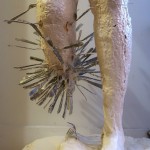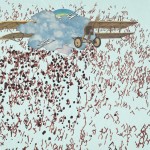Born Lansing, MI, 1981 / BFA, College for Creative Studies / Lives in Hamtramck, MI
At the edge of the city, one empty lot from the noise of I-75, George Rahme lives and works in a small, unassuming Hamtramck house. His studio occupies the second floor. With no partition walls, the space is open and provides plenty of room for a drafting table and enough area on the floor to spread out and assemble his large-scale collage pieces.
One of his early works, a crudely rendered human figure, is stationed just inside his entry door. The body is made from foam with applied resin. Its right leg is truncated below the knee and stuck with forks. Titled Exit Eden (2004), it was his first in a series of sculptures regarding living with a disability.
“I was born with severe club foot,” Rahme says. “My feet were turned in and upside-down. I had surgery, and they put a pin in at six months. I had casts to wear until I was two. At a young age, I had arthritis. I spent time in a wheelchair. It framed my identity, and in the early days of my sculpture work, I used my feet as a reference.”
After graduating from C.C.S., Rahme discovered that toxins in oil paint and sculptural mediums such as resin were further compromising his health, so he started searching for safer mediums. As an exercise, he began using heavy applications of a low-odor, latex house paint—the color duck egg blue—over record albums to isolate images and release them from their original context. The piece Cannonball (2009) began on an Atlantic Rhythm Section album depicting a crowd scene at an outdoor arena. Rahme meticulously painted out the landscape and most of the bodies too, leaving only their outstretched arms, which appear small and worm-like. “They’re all reaching for something. Anxiety has a lot to do with it,” he says. “We’re all anticipating something.”
Inspired by an invitation to participate in a book art exhibition, Rahme started collecting ’70s romance novels. He removed the covers, joined them in booklet form with a scissor-fold, then began the redactive process of painting out the original gaudy cover art. The resulting piece, Woman of Fire Man of Flame (2010), depicts amorous couples in all manner of embrace gazing into each other’s eyes, or with heads thrown back in ecstasy, or in one case, with no head at all.
The process of isolating objects by painting out their background naturally led Rahme to collage. He began using scissors and a utility knife to extract objects from their source, then utilized dry-mount adhesive to apply the images to canvas, creating a new context for them. His first significant, large-scale collage work was also based on images from romance novels. The bodies continued to embrace but were now in a lush cut-and-paste landscape with waterfalls, mountains, and moons. He juxtaposed the romantic couples with elements of wild menace, such as the fire-breathing tiger of Flower of The Moon (2011). The creature might just barbecue the lovers. These works are full of passion and disaster, with unexpected sources of potential harm and pain.
By the end of 2011, Rahme’s work had grown significantly in scale. His piece Water Over Fire (2011), was the first of a series of 8×8 foot collages on canvas. Gone were the peopled images from romance novels. The central image of Water Over Fire is an I Ching symbol regarding achievement, success, and movement into a new phase. The symbol appears hot with light as if the realization it declares is so intense it blows apart all previous notions.
Gradually, Rahme’s work began focusing on a calmer sort of energy, specifically showers of welding sparks. “These are factory images,” he says. “Detroit images.” The images that Rahme distills from found welding photos have none of the noise, smoke, or sweat of the factory. Disconnected from all surrounding objects, the sparks stand alone on panels of silk or wool or shimmering polyester. Though the subject is intense heat, the pieces in this series are somewhat peaceful. One example, Astral Traveling (2016), is a spindly, bright flower made from flying bits of molten metal.
Standing in his living room, before an early piece in his weld series, Eternal Flame (2012), Rahme recites the title of his 2017 exhibition at Simone DeSousa Gallery, “‘Soldier of Stars,’” “That’s me,” he says. “This series is about all I’ve overcome. Emotionally and physically. These pieces are meditations. Maybe even self-portraits.”
Steve Hughes, January 2018
Copyright Essay’d 2018







